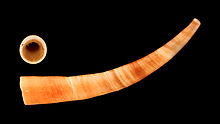Tusk shell
| Tusk shells Temporal range: Mississippian–Recent |
|
|---|---|
 |
|
| A shell of the scaphopod Antalis vulgaris from France | |
| Scientific classification | |
| Kingdom: | Animalia |
| Phylum: | Mollusca |
| Class: |
Scaphopoda Bronn, 1862 |
| Orders | |
The tusk shells or tooth shells, often referred to by the more-technical term scaphopods /ˈskæfəˌpɒd/ (Greek, "boat-footed"), are members of a class of shelled marine mollusc with worldwide distribution, and are the only class of exclusively infaunal marine molluscs. Shells of species within this class range from about 0.5 to 15 cm in length. Members of the order Dentaliida tend to be significantly larger than those of the order Gadilida.
These molluscs live in soft substrates offshore (usually not intertidally). Because of this subtidal habitat and the small size of most species, many beachcombers are unfamiliar with them; their shells are not as common or as easily visible in the beach drift as the shells of sea snails and clams.
Molecular data suggest that the scaphopods are a sister group to the cephalopods, although higher-level molluscan phylogeny remains somewhat unresolved.
The morphological shape of the scaphopod body makes it difficult to orient it satisfactorily. As a result, researchers have often disagreed as to which direction is anterior/ posterior and which is ventral/ dorsal. According to Shimek and Steiner, "[t]he apex of the shell and mantle are anatomically dorsal, and the large aperture is ventral and anterior. Consequently, the concave side of the shell and viscera are anatomically dorsal. The convex side has to be divided into anteriorly ventral and dorsally posterior portions, with the anus as the demarcation. Functionally, as in cephalopods, the large aperture with the foot is anterior, the apical area posterior, the concave side dorsal and the convex side ventral."
...
Wikipedia
